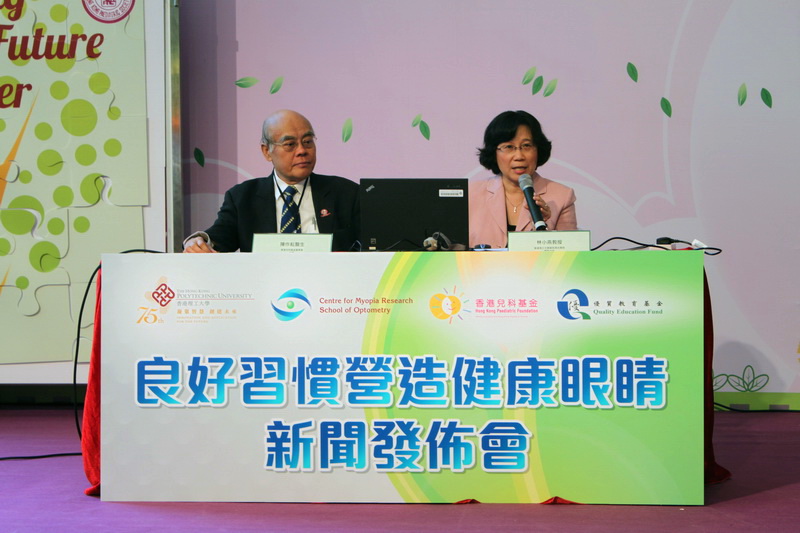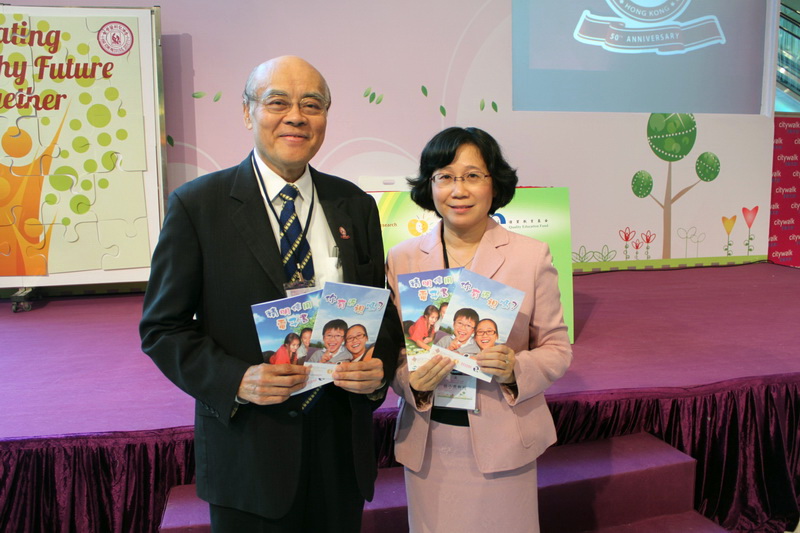Myopia is a common vision problem among Hong Kong students. To better understand the latest trend of myopia among Hong Kong school children, the School of Optometry (SO) of The Hong Kong Polytechnic University (PolyU) collaborated with the Hong Kong Paediatrics Foundation to carry out a two-year “Smart Practice for Healthy Vision for School Children” project in the Kwai Tsing District. The project was funded by the Quality Education Fund and supported by the Kwai Tsing Safe Community and Healthy City.
PolyU optometrists and optometry students provided on-site vision screenings and carried out a survey to over 5,000 children studying at primary and secondary schools in the Kwai Tsing District. The survey found that the prevalence of myopia is similar to previous studies, but the percentage of students having high myopia (-6.00D (600 degrees) or stronger) recorded a rising trend. It also found that school children did not have significant knowledge of primary eye care and more efforts should be put into the education of school children in this regard.
SO kicked off the project in February 2011 and provided eye screening to 5,148 school children from 15 schools (9 primary schools and 6 secondary schools). Among them, 4,916 are ethnic Chinese children, and their myopic prevalence was similar to previous studies with about 50% of children aged nine and nearly 70% of children aged 12 or above being myopic. However, the degree of myopia among the children recorded a rising trend.
Professor Carly Lam, Head of SO, said, “the average degree of myopia for children aged 12 was -1.45D (145 degrees) twenty years ago, but our latest findings showed an average of -2.11D (211 degrees), suggesting that children were suffering from higher myopia now than before. There were 5.2% of subjects with -6.00D (600 degrees) or stronger in right eye compared with 4% in previous surveys, which means that the myopia problem has become more serious. If the criteria are relaxed to either one eye with -6.00D or above, the high myopia percentage will even rise to 7.1%.”
Professor Lam also analyzed the increasing myopia trend and said, “school children are now having more homework and need to read or do assignments with short reading distance requirements, if compounded by poor illumination, students will be more likely to have higher degree of myopia. On top of this, the popularity of electronic digital products, such as mobile phones and handheld game consoles, which are used excessively by these young and trendy subjects, will further affect their quality of vision. Recent research also suggested that school children with more outdoor activities will be less prone to the onset of myopia and less increase in degree of myopia. However, Hong Kong students are less exposed to outdoor activities and this may be a cause of increasing myopia onset.”
Overall, SO received 5,394 completed survey forms from students and parents. Results showed that about 30% of them did not have any eye checks in the past two years. Nearly 40% thought that “eye checks are needed only when there are vision problems”, over 80% were not aware of the importance of regular eye checks and only 20% had the knowledge on eye diseases related to high myopia. Professor Lam pointed out that all students should receive comprehensive eye examinations once a year to ensure proper ocular health. More resources should be allocated to educate children on eye care knowledge.
Professor Lam added, “The American Optometric Association has a 20/20/20 eye care rule, suggesting that people should look at far away objects 20 feet away for at least 20 seconds after 20 minutes of work for eye relaxation. However, only 66% of the subjects took rests after intensive eye work. When using digital electronic gadgets or computer screens, about 70% did not maintain correct minimal distances from eye to screen and this will adversely affect their vision.”
Dr Chan Chok Wan, President of the Hong Kong Paediatric Foundation, said at the press conference, “according to PolyU’s survey, over 70% of school children engage in less than eight hours a week in outdoor activities and only six hours on average. Recent research suggest that outdoor activities can help school children to avoid having myopia and/or have less increase in the degree of myopia. We hope parents and teachers can arrange more outdoor activities or sports for the children.”
Professor Lam and Dr Chan urged parents and teachers to improve school children’s knowledge on eye health and correct any bad habits in eye care, which will in turn lead to the lessening of myopia prevalence and intensity among Hong Kong school children.
*****

